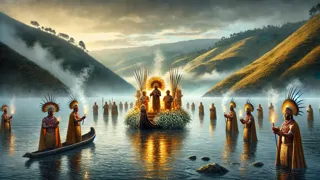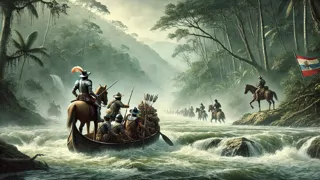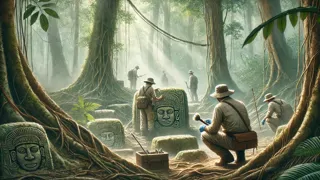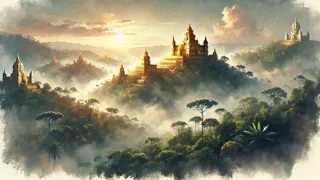Introduction
Nestled within the misty highlands of Colombia, the legend of El Dorado first took shape as a golden promise whispered by Muisca elders. For centuries, this shimmering myth spoke of a city made entirely of gold, where rivers of precious metal flowed beneath temples crowned by ochre stones. European emissaries and daring adventurers heard word of this enchanted place and set sail across treacherous seas, driven by the single-minded pursuit of unimaginable wealth. Dense jungles and jagged mountains hid secrets older than memory, yet the hope of untold riches pushed men onward through stifling heat and deadly swamps. Stories mingled with rumor: chiefs doused in gold dust offering gifts at the water’s edge; opulent pyres illuminating the night sky; emerald forests teeming with exotic beasts. As each expedition departed, new tragedies unfolded in the humid shadows, where hunger, fever, and betrayal claimed more victims than the promise of gold ever could. Despite warnings from native guides, conquistadors pressed into uncharted valleys, clutching crucifixes in one hand and maps scrawled in uncertain ink in the other. The magnetic pull of that golden city transcended reason, fusing faith and greed into a quest as beautiful as it was deadly. In this chronicle, we journey through the birth of the myth, the fevered chase of explorers, and the enduring legacy of El Dorado, a cautionary tale that echoes through time. What drove so many to abandon home and hearth? And why does the dream of a golden paradise still hold sway over our collective imagination? Prepare to uncover a tale of indomitable ambition, tragic loss, and the shimmering allure of golden dreams.
Origins of the Legend: The Muisca and the Golden Chief
Long before the first Spanish vessel appeared on the horizon, the high plains of what is now central Colombia were home to the Muisca confederation, a sophisticated society renowned for its skilled metalwork and intricate social rituals. Perched above sea level, this rugged terrain offered fertile soils and shimmering lakes that reflected emerald peaks under the equatorial sun. To the Muisca, gold was not just a currency but a sacred element imbued with spiritual energy. Artisans hammered and shaped oro fino into delicate masks, offerings, and talismans, each piece carrying blessings for harvests or healing. The most sacred ceremony centered on Lake Guatavita, a watery altar rising like a polished mirror amid rolling hills and sacred groves. Once a year, the new chief would be draped from head to toe in fine gold dust, his body aglow beneath ceremonial feathers and beads. In a ritual both solemn and celebratory, he would stand atop a barge adorned with flowers, while priests chanted invocations to the Sun god. As drums echoed in the valley, offerings of emeralds, precious textiles, and metalwork were cast into the lake's crystal depths, forging a covenant between earth and sky. Witnesses spoke of the water’s surface igniting in a thousand ripples of light, as though the very heart of creation had been set ablaze. These rites, passing from generation to generation, gave rise to a myth of immeasurable wealth—a promise that one day, a city of pure gold would emerge from the mists. The legend wove itself into every aspect of Muisca life, from the governance of villages to the songs whispered around communal fires. It was a story that transcended earthly ambition, tying the mortal world to realms of divine splendor. Descendants of those earliest storytellers still recall verses of those chants, their words a testament to an age when gold was the language of the gods.

By the early sixteenth century, tales of the Muisca's sacred gold reached Spanish ears through merchants and missionaries venturing into the New World. Reports filtered back to Europe of a lake glittering with treasure, and a city built from beaten metal. The Spanish crown, strapped by war debts and eager to expand its empire, authorized expeditions with promises of titles, land, and sacred indulgences. Conquistadors—soldiers hardened by long campaigns in Mexico and Guatemala—marshaled their forces, confident that wealth awaited them as spoils of conquest. Yet each journey into the interior tested the limits of endurance. Armed with arquebuses and steel armor, the Spaniards faced torrential rains that turned narrow trails into quagmires, and swarms of mosquitoes that carried fevers more deadly than enemy fire. Supply lines stretched thin across unforgiving landscapes, forcing men to forage for roots and hunt elusive game. Chains of command frayed as frustration grew; ambitious captains quarreled over maps scrawled in the blood of previous expeditions. In campfire councils under starless skies, veterans whispered of betrayal by guides who led them astray, and of raiders from rival tribes lying in wait along the riverbanks. Despite the hardships, the Spanish belief in divine sanction imbued them with unwavering conviction—they had been chosen to claim these lands, and no obstacle could bar their path.
Muisca leaders, torn between preserving ancestral traditions and confronting foreign invaders, initially offered cautious diplomacy. They presented small offerings of gold and emeralds, hoping to satisfy the newcomers’ avarice without resorting to open conflict. But when larger forces pressed deeper into tribal territories, the balance shifted. Armed skirmishes erupted along narrow passes, leaving villages in ashes and forging bitter enmities that would echo for centuries. For the Muisca, the desecration of Lake Guatavita and sacred groves felt like an assault on the soul of their people. In retaliation, they melted down lesser treasures and scattered them across hidden vales, burying their secrets beneath thick layers of earth and vegetation. It was an act both defiant and hopeful—a way to safeguard their legacy while denying their adversaries the prize they sought so desperately. Word of these hidden caches only fueled the legend further, as each discovery of a few stray artifacts sparked new dreams and fresh horrors. Thus, the myth of El Dorado transcended any single ceremony or ruler; it became a living force that shaped alliances and enmities alike. To this day, the echoes of those early conflicts endure in local folklore, a reminder that the true treasure may lie not in material wealth, but in the stories that bind communities through time.
The Golden Hunt: Conquistadors' Quest for Riches
As dawn broke over Cartagena and Santa Marta, flotillas of wooden vessels loaded with steel cannons and heavy provisions embarked on an odyssey into the heart of South America. Conquistadors such as Gonzalo Jiménez de Quesada led columns of infantry and cavalry upriver along the Magdalena, their banners flapping against a sky streaked with rose and gold. Each man carried letters patent from the Spanish crown—official warrants that promised land and lordship to anyone brave enough to carve out an empire beyond the known seas. Scouts probed ahead, skirting swampy lagoons where caymans lurked and poisonous reeds snared the unwary. When the trail narrowed into steep ravines, pack mules groaned under loads of gunpowder and armaments, and soldiers hacked at vines with machetes to forge a path. Even seasoned veterans found the soaring humidity oppressive, their armor quickly rusting under heavy monsoon clouds. Yet with every step deeper into the jungle, the fevered anticipation of visible gold grew. Rumors told of riverbanks encrusted with nuggets, and of petrified temples cloaked in sheets of beaten metal so thick they seemed to glow at twilight. Letters home described city walls of pure gold, reflecting torchlight across vast plazas, while camp scribes encoded promises of landholdings that would elevate families to the ranks of nobility.

But the unforgiving wilderness demanded its own price. Fever, dysentery, and malaria swept through makeshift encampments like a silent plague, reducing seasoned soldiers to hollow shells of their former selves. The constant hum of insects and the haunting calls of howler monkeys became the ambient soundtrack of a nightmare from which there was no waking. Attempts to negotiate safe passage with indigenous communities often ended in ambushes or betrayals by rival tribes who perceived the strangers as harbingers of death and disease. Horses, unaccustomed to the humid lowlands, balked at narrow trails and perished in mire that swallowed their hooves. Supply wagons buckled underneath their burdens, forcing expeditions to leave behind precious artillery in exchange for feeble rafts carved from hollowed logs. Each loss of life dampened morale, but accounts of even the smallest golden trinkets recovered along the way stoked fresh resolve. Captains offered extra rations and promotions to men who ventured further into the unknown, fostering a tense rivalry that sometimes led to duels or desertions. In the murky waters of ambition, fear and hope were forever entwined.
As weeks turned into months, the idea of a golden city evolved from a tangible goal into an obsession that consumed every letter, every whispered council, and every prayer. Names like Francisco Orellana and Sebastián de Belalcázar became synonymous with daring and desperation. When a group finally stumbled upon the fabled Lake Guatavita, they found not a shrine of riches but a shallow basin strewn with scattered ornaments, its surface muddied by countless failed salvage attempts. Anger and disillusionment welled within their ranks; some turned to desecration, ripping sacred art from communal altars and casting aside the unyielding earth in fits of rage. Others fell silent, haunted by the faces of fallen comrades and the taunting mockery of a dream just beyond their grasp. Returning to the coast, they carried jars of murky water pigmented by dissolved gold, and tales of anguish that outshone any treasure map. Though no grand city emerged from the mist, the legend refused to die—it merely transformed, seeping into the margins of history books and fueling further expeditions. Centuries later, writers, artists, and fortune seekers would still gaze toward the jungles of Colombia with hearts poised between greed and wonder.
Legacies and Losses: The Enduring Myth of El Dorado
Long after the last conquistador retreated to coastal settlements, the legend of El Dorado continued to captivate explorers, writers, and dreamers in Europe and beyond. Tales of an impenetrable city of gold threaded through illuminated manuscripts and baroque paintings, sparking the imaginations of those who could not bear the thought that such wonders might lie unclaimed. In the Enlightenment era, naturalists and cartographers embarked on scientific expeditions, blending the goal of discovery with the pursuit of prime specimens for royal museums. The image of a sunlit metropolis carved from precious metals became shorthand for unattainable perfection, inspiring poets to pen verses about human folly and philosophers to warn against the corrupting nature of greed. Each map that labeled an 'X' across the South American interior was more than a directional tool—it was a symbol, a challenge to be conquered by the most intrepid minds of the age. Museums in Madrid and Paris displayed artifacts claimed to have come from Muisca sites, though questions of provenance and authenticity haunted their halls. Even the echo of the Muisca drums seems to resonate across centuries, reminding us of a time when gold served the spirit as much as the crown.

In the modern era, archaeologists armed with GPS and remote sensing have dared to unravel the myth with scientific rigor. Layers of sediment removed from Lake Guatavita have revealed tiny fragments of gold, but no evidence of grand ceremonial barges or sunken temples. Geologists have traced the origins of alluvial gold to mountain veins far from any legendary city, while linguists have pieced together Muisca oral traditions that speak more of spiritual values than material kingdoms. Yet the romantic image persists—film directors and novelists continue to frame El Dorado as a lost utopia, and tourism boards in Colombia lean into the narrative, offering 'El Dorado experiences' at reconstructed indigenous sites. It is a delicate dance between honoring ancestral heritage and perpetuating a myth that once fueled violence and exploitation. Educational programs now collaborate with indigenous communities to present nuanced histories that emphasize respect for ecosystems and cultural resilience over the simple promise of treasure. Collaborations with local historians ensure that exhibitions respect the perspectives of indigenous descendants and avoid romanticizing a painful past.
Today, the jungles and mountains of Colombia bear the scars of centuries of human endeavor, but they also stand as living testaments to nature’s capacity for renewal. Eco-tourism initiatives invite travelers to swim in emerald lakes, traverse cloud forests, and learn traditional weaving techniques from descendants of the Muisca. Workshops on sustainable gold mining offer an alternative narrative—one that acknowledges the painful legacy of extraction while empowering local communities to steward their resources responsibly. In literature and art, El Dorado remains a potent metaphor for the pursuit of dreams that straddle the line between ambition and folly. It reminds us that true richness lies not in piles of metal, but in the stories we inherit and the stewardship we practice. As long as mankind longs for the glint of possibility on the horizon, the myth of a golden city will endure, challenging each new generation to ask what they value most. Is the price of that glimmer worth the lives it may cost? And if the truest treasures are lessons learned, perhaps the greatest discovery of all is our own capacity for reflection and change. In this way, El Dorado evolves as a mirror, reflecting both our highest aspirations and deepest regrets.
In recent decades, filmmakers and writers have sought to reclaim the narrative from exploitative angles, collaborating with indigenous artists to tell stories that honor Muisca heritage. Documentaries delve into linguistic reconstructions, while graphic novels portray the complex social dynamics that birthed the golden myth. Even fashion designers draw inspiration from ancient motifs, weaving patterns that echo the geometry of Muisca textiles and golden ornaments. Through these creative endeavors, El Dorado transforms once again—from a beacon of conquest to a symbol of cultural continuity. And so, the journey that began with dusted chiefs at Lake Guatavita extends even now, as voices long silenced find resonance on global stages.
Conclusion
As we look back on the fabled quest for El Dorado, it becomes clear that the true cost of gold cannot be measured in coins or gemstones alone. Hundreds of lives were sacrificed to fevered ambition, and countless landscapes were altered by the search for fleeting glimmers beneath the jungle canopy. Yet the enduring myth offers more than a cautionary tale of greed; it reminds us of humanity's boundless capacity for hope, our readiness to seek something greater than ourselves even against insurmountable odds. In the modern world, where riches often blur the line between necessity and indulgence, the story of El Dorado urges us to consider what we truly value. Are we chasing hollow promises that shimmer like fools’ gold, or are we forging legacies built on respect, stewardship, and empathy? The Muisca elders would say that real wealth lies in the bonds that unite communities, in the songs passed from one generation to the next, and in the harmony between people and the land that sustains them. If we heed these lessons, the golden city becomes more than a lost destination; it becomes a living metaphor for the treasures we create through compassion, wisdom, and shared purpose. May the echoes of El Dorado guide us toward pursuits that enrich both spirit and soil, ensuring that tomorrow's heirs inherit not empty vaults, but worlds brimming with meaning.



















